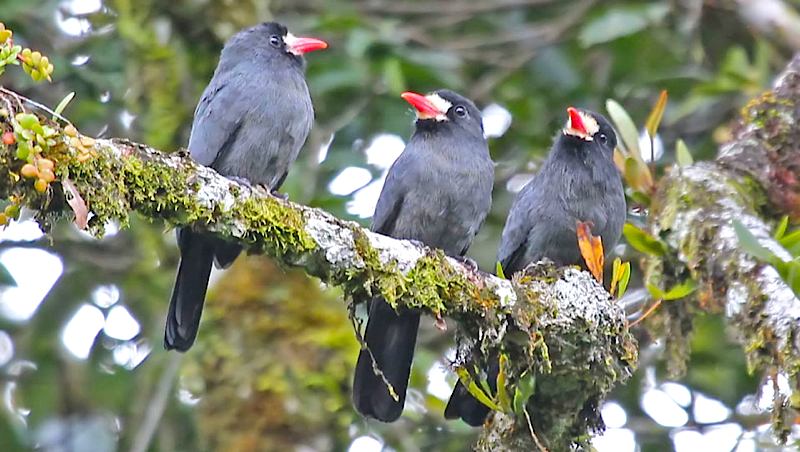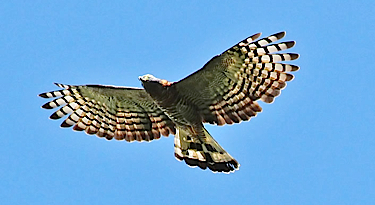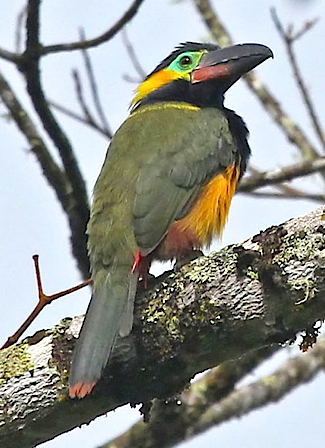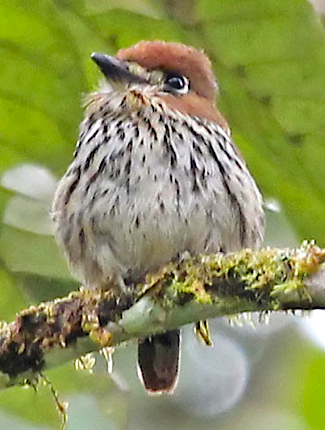For our tour description, itinerary,
past triplists, dates, fees, and more, please VISIT OUR TOUR PAGE.
See this triplist in printable PDF format with media only on
page 1.

A curious trio of
White-fronted Nunbirds trying to sort out where the nunbirds
they just heard have gotten to! (Photo by tour participant
Paul Cozza)
Our Magnetic North tour provided an excellent opportunity to
experience the highly complex Maranon valley region--such a
unique and beautiful part of Peru! An important geographic
barrier in bird distribution north-south in the Andes, the
valley creates special conditions which allow a unique
assemblage of birds characterized by many bird taxa restricted
to this region. These bird species include the Marvelous
Spatuletail, Royal Sunangel, Long-whiskered Owlet, Johnson’s
Tody-Tyrant, and the new species of Turdus, the Varzea Thrush,
among many others.
Our tour began in the Juan Guerra area outside of the city of
Tarapoto. Here we had one of our first specialties, the
Northern Slaty-Antshrike. It was also here that we saw a pair
of Rufous Casiornis, a Bluish-fronted Jacamar, and the
Hook-billed Kites, among others. We birded close to the Mayo
river while eating our lunch and saw a group of elegant and
graceful Swallow-tailed Kites flying around us. After that we
headed to our first hotel of the tour located in the “city of
the orchids,” Moyobamba.
The following early morning we drove to Morro de Calzada in
order to look for some nightbirds. We were rewarded in our
efforts by getting very good views of a responsive Little
Nightjar that Pepper was able to keep in his spotlight while
it was in flight! We also had some responses from Spot-tailed
and Blackish nightjars, as well as from Pauraques. While
enjoying our breakfast next to the road, we saw a small group
of Saddleback Tamarins foraging (having breakfast?) across
from where we were! Once refueled and energized, we birded
along our way to the interpretation center, coming across
White-lored and Sooty-headed tyrannulets, Olivaceous
Woodcreeper, Lettered Aracari, Broad-billed Motmot,
Green-backed and Blue-crowned Trogons, a pair of Striolated
Puffbirds, and a responsive pair of Lineated Woodcreepers. We
continued our drive until the Puente Verde area where, in
order to give our crew some time to prepare our lunch, we
stopped and birded the road. We did not have to travel too far
before a flock came across our path and we started to identify
birds: Ecuadorian Tyrannulet, Ash-browed Spinetail,
Rufous-rumped Foliage-gleaner, Orange-eared, Paradise, Golden,
Spotted, and Masked tanagers, and also the endemic
Black-bellied and Yellow-crested tanagers! After lunch, we
looked for Torrent Ducks from the bridge and found a male
which gave us some good looks before flying out of sight.
Seeing that Sickle-winged Guan in the middle of the river
deserves special recognition too. From this point we headed to
our final destination at the Owlet Lodge.
After long days of traveling, we decided to sleep well our
first night and try for the Long-whiskered Owlet the second
night in order to be rested and recovered. So, the following
night we all hiked 900 meters to await dusk and--more
importantly--for the owlet to start singing. Around 6:20 p.m.
it began to call (along with the Rufous-banded Owl!). We
started some playback, hoping to get it close enough for good
looks. Unfortunately we did not succeed this time, despite the
fact that Roberto was with us! Two nights later we returned,
but again, luck was not on our side and we heard but did not
see the owlet.
Our tour encountered very unusual weather that seems to have
taken a toll on bird activity, making it difficult to find
certain species, such as the Rusty-breasted, Ochre-fronted,
Chestnut, and Rusty-tinged antpittas, as well as Crested and
Golden-headed quetzals. Despite this, we had a terrific trip
filled with many amazing highlights. Where to begin? Remember
the Oilbird ravine and those swifts swooping in and out of it?
And the Red-ruffed Fruitcrow that Bob found for us along the
road? Or, the 42 species of hummingbirds we saw--out of a
total of more than 50 that can be seen on this tour! How about
the Marvelous Spatuletail coming to the feeders and staging
that spectacular performance? And how can we forget the
no-show Long-whiskered Owlet that came to tease us not once‚
but twice! Oh and remember the “Cliff” Flycatcher’s spot and
all those wonderful birds we saw there? Perhaps it should be
renamed the pygmy-owl spot! And of course we cannot forget the
flocks in Afluente, the Waqanki feeders and its amazing
hummers, and that cooperative Golden-collared Toucanet at the
tunnel our last birding day of the tour.
It was a great tour filled with many great birds, and it was
a sincere pleasure to meet and travel with each of you--such a
highly skilled birding group! The opportunity to get to know
enthusiastic bird-lovers from around the world is certainly
one of the highlights of being a guide, and we hope to be in
the field with each of you on future tours. Our thanks to
Maggie Burnett from the Field Guides office for sharing in
this journey with us, it was great having you in Peru.
Additionally, we are very grateful to our superb local guides
Roberto and Santos, and our amazing Manu Expeditions crew.
Thanks for ensuring a smooth travel experience and taking such
good care of us throughout the tour.
--Pepe
For more information about this tour, including future
departures, visit our website at www.fieldguides.com.
And to see this same triplist online, go to http://www.fieldguides.com/triplists/pms12LIST.pdf
and you will find the list in its entirety.
KEYS FOR THIS LIST
One of the following keys may be shown in brackets for
individual species as appropriate: * = heard only, I =
introduced, E = endemic, N = nesting, a = austral migrant, b =
boreal migrant
Tinamidae (Tinamous)
CINEREOUS TINAMOU (Crypturellus cinereus) [*]
TATAUPA TINAMOU
(Crypturellus tataupa) [*]
Anatidae (Ducks, Geese, and Waterfowl)
TORRENT DUCK (Merganetta armata)
Cracidae (Guans, Chachalacas, and
Curassows)
SPECKLED CHACHALACA (Ortalis guttata)
ANDEAN GUAN
(Penelope montagnii)
SICKLE-WINGED GUAN
(Chamaepetes goudotii)
Ardeidae (Herons, Egrets, and Bitterns)

The distinctive
paddle-shaped wings help identify a soaring Hook-billed
Kite. (Photo by tour participant Paul Cozza)
GREAT EGRET (Ardea alba)
SNOWY EGRET
(Egretta thula)
LITTLE BLUE HERON
(Egretta caerulea)
CATTLE EGRET
(Bubulcus ibis)
STRIATED HERON
(Butorides striata)
Threskiornithidae (Ibises and Spoonbills)
PUNA IBIS (Plegadis
ridgwayi)
Cathartidae (New World Vultures)
BLACK VULTURE (Coragyps atratus)
TURKEY VULTURE
(Cathartes aura)
GREATER
YELLOW-HEADED VULTURE (Cathartes
melambrotus)
KING VULTURE
(Sarcoramphus papa)
Accipitridae (Hawks, Eagles, and Kites)
HOOK-BILLED KITE (Chondrohierax uncinatus)
SWALLOW-TAILED
KITE (Elanoides forficatus)
DOUBLE-TOOTHED
KITE (Harpagus bidentatus)
BLACK-CHESTED
BUZZARD-EAGLE (Geranoaetus
melanoleucus)
TINY HAWK (Accipiter superciliosus)
ROADSIDE HAWK
(Buteo magnirostris)
WHITE-RUMPED HAWK
(Buteo leucorrhous)
BLACK HAWK-EAGLE
(Spizaetus tyrannus)
ORNATE HAWK-EAGLE
(Spizaetus ornatus)
BLACK-AND-CHESTNUT
EAGLE (Spizaetus isidori)
Falconidae (Falcons and Caracaras)
YELLOW-HEADED CARACARA (Milvago chimachima)
AMERICAN KESTREL
(Falco sparverius)
BAT FALCON
(Falco rufigularis)
Rallidae (Rails, Gallinules, and Coots)
RUSSET-CROWNED CRAKE (Anurolimnas viridis)
PLUMBEOUS RAIL
(Pardirallus sanguinolentus)
Charadriidae (Plovers and Lapwings)
ANDEAN LAPWING (Vanellus resplendens)
Recurvirostridae (Stilts and Avocets)
BLACK-NECKED STILT (Himantopus mexicanus)
Laridae (Gulls, Terns, and Skimmers)
LARGE-BILLED TERN (Phaetusa simplex)
Columbidae (Pigeons and Doves)
ROCK PIGEON (Columba livia) [I]
SCALED PIGEON
(Patagioenas speciosa)
BAND-TAILED PIGEON
(Patagioenas fasciata)
PLUMBEOUS PIGEON
(Patagioenas plumbea)
RUDDY PIGEON
(Patagioenas subvinacea)
EARED DOVE
(Zenaida auriculata)
RUDDY GROUND-DOVE
(Columbina talpacoti)
BLUE GROUND-DOVE
(Claravis pretiosa)
WHITE-TIPPED DOVE
(DECOLOR) (Leptotila verreauxi
decolor) [*]
WHITE-TIPPED DOVE
(BRASILIENSIS GROUP) (Leptotila
verreauxi decipiens)
[*]
Psittacidae (Parrots)
ROSE-FRONTED PARAKEET (Pyrrhura roseifrons)
SCARLET-FRONTED
PARAKEET (Aratinga wagleri)
WHITE-EYED
PARAKEET (Aratinga
leucophthalma)
COBALT-WINGED
PARAKEET (Brotogeris
cyanoptera)
BLUE-HEADED PARROT
(Pionus menstruus)
SPECKLE-FACED
PARROT (WHITE-CAPPED) (Pionus
tumultuosus seniloides)
SCALY-NAPED PARROT
(Amazona mercenaria)
Cuculidae (Cuckoos)
SQUIRREL CUCKOO (Piaya cayana)
SMOOTH-BILLED ANI
(Crotophaga ani)
Strigidae (Owls)
WHITE-THROATED SCREECH-OWL (Megascops albogularis)
[*]
BAND-BELLIED OWL
(Pulsatrix melanota) [*]
ANDEAN PYGMY-OWL
(Glaucidium jardinii)
[*]
FERRUGINOUS
PYGMY-OWL (Glaucidium
brasilianum)
LONG-WHISKERED
OWLET (Xenoglaux loweryi)
[*]
RUFOUS-BANDED OWL
(Ciccaba albitarsis) [*]
Caprimulgidae (Nightjars and Allies)
COMMON PAURAQUE (Nyctidromus albicollis)
SPOT-TAILED
NIGHTJAR (Caprimulgus
maculicaudus)
LITTLE NIGHTJAR
(Caprimulgus parvulus)
BLACKISH NIGHTJAR
(Caprimulgus nigrescens) [*]
Steatornithidae (Oilbird)
OILBIRD (Steatornis
caripensis)
Apodidae (Swifts)
CHESTNUT-COLLARED SWIFT (Streptoprocne rutila)
WHITE-COLLARED
SWIFT (Streptoprocne zonaris)
WHITE-TIPPED SWIFT
(Aeronautes montivagus)
FORK-TAILED
PALM-SWIFT (Tachornis
squamata)
Trochilidae (Hummingbirds)
WHITE-NECKED JACOBIN (Florisuga mellivora)
RUFOUS-BREASTED
HERMIT (Glaucis hirsutus)
GREEN HERMIT
(Phaethornis guy)
KOEPCKE'S HERMIT
(Phaethornis koepckeae)
LONG-TAILED HERMIT
(Phaethornis superciliosus)
GRAY-CHINNED
HERMIT (Phaethornis
griseogularis)
GREEN-FRONTED
LANCEBILL (Doryfera ludovicae)

Golden-collared
Toucanets can be quite lethargic once lured into view by
playback. This male was a classic example, hanging around
in the open for a long time after we'd called him in.
(Photo by tour participant Paul Cozza)
BROWN VIOLETEAR (Colibri delphinae)
GREEN VIOLETEAR
(Colibri thalassinus)
SPARKLING
VIOLETEAR (Colibri coruscans)
BLACK-THROATED
MANGO (Anthracothorax
nigricollis)
AMETHYST-THROATED
SUNANGEL (Heliangelus
amethysticollis)
ROYAL SUNANGEL
(Heliangelus regalis)
RUFOUS-CRESTED
COQUETTE (Lophornis delattrei)
SPECKLED
HUMMINGBIRD (Adelomyia
melanogenys)
LONG-TAILED SYLPH
(Aglaiocercus kingi)
GREEN-TAILED
TRAINBEARER (Lesbia nuna)
RUFOUS-CAPPED
THORNBILL (Chalcostigma
ruficeps)
GREENISH PUFFLEG
(Haplophaedia aureliae)
EMERALD-BELLIED
PUFFLEG (Eriocnemis alinae)
MARVELOUS
SPATULETAIL (Loddigesia
mirabilis)
[E]
BRONZY INCA
(Coeligena coeligena)
COLLARED INCA
(Coeligena torquata)
GREAT SAPPHIREWING
(Pterophanes cyanopterus)
CHESTNUT-BREASTED
CORONET (Boissonneaua
matthewsii)
BOOTED RACKET-TAIL
(Ocreatus underwoodii)
RUFOUS-VENTED
WHITETIP (Urosticte
ruficrissa)
FAWN-BREASTED
BRILLIANT (Heliodoxa
rubinoides)
VIOLET-FRONTED
BRILLIANT (Heliodoxa
leadbeateri)
WHITE-BELLIED
WOODSTAR (Chaetocercus
mulsant)
LITTLE WOODSTAR
(Chaetocercus bombus)
AMETHYST WOODSTAR
(Calliphlox amethystina)
BLUE-TAILED
EMERALD (Chlorostilbon
mellisugus)
GRAY-BREASTED
SABREWING (Campylopterus
largipennis)
NAPO SABREWING
(Campylopterus villaviscensio)
FORK-TAILED
WOODNYMPH (Thalurania furcata)
MANY-SPOTTED
HUMMINGBIRD (Taphrospilus
hypostictus)
WHITE-BELLIED
HUMMINGBIRD (Amazilia
chionogaster)
ANDEAN EMERALD
(Amazilia franciae cyanocollis)
SAPPHIRE-SPANGLED
EMERALD (Amazilia lactea)
GOLDEN-TAILED
SAPPHIRE (Chrysuronia oenone)
WHITE-CHINNED
SAPPHIRE (Hylocharis cyanus)
Trogonidae (Trogons)
GREEN-BACKED TROGON (Trogon viridis) [N]
BLUE-CROWNED
TROGON (Trogon curucui)
COLLARED TROGON
(Trogon collaris)
MASKED TROGON
(Trogon personatus)
Momotidae (Motmots)
BROAD-BILLED MOTMOT (Electron platyrhynchum) [*]
Bucconidae (Puffbirds)
STRIOLATED PUFFBIRD (Nystalus striolatus)
LANCEOLATED
MONKLET (Micromonacha
lanceolata)
WHITE-FRONTED
NUNBIRD (Monasa morphoeus)
SWALLOW-WINGED
PUFFBIRD (Chelidoptera
tenebrosa)
Galbulidae (Jacamars)
BLUISH-FRONTED JACAMAR (Galbula cyanescens)
Capitonidae (New World Barbets)

Lanceolated
Monklets can be inconspicuous little devils, but
fortunately they can also be pretty inactive, so when you
are lucky enough to spot one, you're likely to get
incredible, lengthy views, as we did. (Photo by tour
participant Paul Cozza)
GILDED BARBET (Capito auratus punctatus)
VERSICOLORED
BARBET (Eubucco versicolor)
Ramphastidae (Toucans)
EMERALD TOUCANET (BLUE-THROATED)
(Aulacorhynchus prasinus
caeruleogularis)
LETTERED ARACARI
(Pteroglossus inscriptus)
CHESTNUT-EARED
ARACARI (Pteroglossus
castanotis)
GOLDEN-COLLARED
TOUCANET (Selenidera
reinwardtii)
BLACK-MANDIBLED
TOUCAN (BLACK-MANDIBLED) (Ramphastos
ambiguus abbreviatus)
WHITE-THROATED
TOUCAN (Ramphastos tucanus
cuvieri) [*]
Picidae (Woodpeckers)
SPECKLE-CHESTED PICULET (Picumnus steindachneri)
YELLOW-TUFTED
WOODPECKER (Melanerpes
cruentatus)
SMOKY-BROWN
WOODPECKER (Picoides
fumigatus)
RED-STAINED
WOODPECKER (Veniliornis
affinis)
GOLDEN-OLIVE
WOODPECKER (Colaptes
rubiginosus)
CRIMSON-MANTLED
WOODPECKER (Colaptes rivolii)
LINEATED
WOODPECKER (Dryocopus
lineatus)
Furnariidae (Ovenbirds and Woodcreepers)
PALE-LEGGED HORNERO (Furnarius leucopus)
AZARA'S SPINETAIL
(Synallaxis azarae)
DARK-BREASTED
SPINETAIL (Synallaxis
albigularis)
ASH-BROWED
SPINETAIL (Cranioleuca
curtata)
RUFOUS-FRONTED
THORNBIRD (Phacellodomus
rufifrons) [N]
EQUATORIAL
GRAYTAIL (Xenerpestes
singularis)
SPOTTED BARBTAIL
(Premnoplex brunnescens)
PEARLED TREERUNNER
(Margarornis squamiger)
MONTANE
FOLIAGE-GLEANER (Anabacerthia
striaticollis)
BUFF-BROWED
FOLIAGE-GLEANER (Syndactyla
rufosuperciliata)
RUFOUS-TAILED
FOLIAGE-GLEANER (Philydor
ruficaudatum)
RUFOUS-RUMPED
FOLIAGE-GLEANER (Philydor
erythrocercum)
BUFF-FRONTED
FOLIAGE-GLEANER (Philydor
rufum)
BUFF-THROATED
FOLIAGE-GLEANER (Automolus
ochrolaemus)
STREAKED XENOPS
(Xenops rutilans)
OLIVACEOUS
WOODCREEPER (Sittasomus
griseicapillus)
OLIVE-BACKED
WOODCREEPER (Xiphorhynchus
triangularis)
MONTANE
WOODCREEPER (Lepidocolaptes
lacrymiger)
LINEATED
WOODCREEPER (Lepidocolaptes
albolineatus)
Thamnophilidae (Typical Antbirds)
RUFOUS-CAPPED ANTSHRIKE (Thamnophilus ruficapillus)
LINED ANTSHRIKE
(Thamnophilus tenuepunctatus)
PLAIN-WINGED
ANTSHRIKE (Thamnophilus
schistaceus) [*]
NORTHERN
SLATY-ANTSHRIKE (MARANON) (Thamnophilus
punctatus huallagae)
VARIABLE ANTSHRIKE
(Thamnophilus caerulescens)
ASH-THROATED
ANTWREN (Herpsilochmus
parkeri)
[E*]
YELLOW-BREASTED
ANTWREN (Herpsilochmus
axillaris) [*]
LONG-TAILED
ANTBIRD (Drymophila caudata)
BLACKISH ANTBIRD
(BLACKISH) (Cercomacra
nigrescens aequatorialis) [*]
BLACKISH ANTBIRD
(FUSCICAUDA) (Cercomacra
nigrescens fuscicauda) [*]
WHITE-BACKED
FIRE-EYE (Pyriglena leuconota)
WHITE-BROWED
ANTBIRD (Myrmoborus
leucophrys) [*]
BLACK-FACED
ANTBIRD (Myrmoborus
myotherinus)
PERUVIAN
WARBLING-ANTBIRD (Hypocnemis
peruviana) [*]
CHESTNUT-TAILED
ANTBIRD (Myrmeciza hemimelaena
hemimelaena) [*]
Formicariidae (Antthrushes)
BARRED ANTTHRUSH (Chamaeza mollissima) [*]
Grallariidae (Antpittas)

This stunning
male Rufous-crested Coquette at the Waqanki feeders was
one of an incredible 42 species of hummingbirds seen on
the tour! (Photo by tour participant Paul Cozza)
RUSTY-TINGED ANTPITTA (Grallaria przewalskii) [*]
OCHRE-FRONTED
ANTPITTA (Grallaricula
ochraceifrons) [*]
RUSTY-BREASTED
ANTPITTA (TUMBES) (Grallaricula
ferrugineipectus leymebambae) [*]
Conopophagidae (Gnateaters)
CHESTNUT-CROWNED GNATEATER (Conopophaga castaneiceps)
Rhinocryptidae (Tapaculos)
TRILLING TAPACULO (Scytalopus parvirostris) [*]
RUFOUS-VENTED
TAPACULO (Scytalopus
femoralis) [*]
WHITE-CROWNED
TAPACULO (Scytalopus atratus)
[*]
Tyrannidae (Tyrant Flycatchers)
WHITE-LORED TYRANNULET (Ornithion inerme)
WHITE-TAILED
TYRANNULET (Mecocerculus
poecilocercus)
YELLOW-BELLIED
ELAENIA (Elaenia flavogaster)
WHITE-CRESTED
ELAENIA (Elaenia albiceps)
SIERRAN ELAENIA
(Elaenia pallatangae)
TORRENT TYRANNULET
(Serpophaga cinerea)
STREAK-NECKED
FLYCATCHER (Mionectes
striaticollis)
OCHRE-BELLIED
FLYCATCHER (Mionectes
oleagineus)
SEPIA-CAPPED
FLYCATCHER (Leptopogon
amaurocephalus)
SLATY-CAPPED
FLYCATCHER (Leptopogon
superciliaris)
MARBLE-FACED
BRISTLE-TYRANT (Phylloscartes
ophthalmicus)
SPECTACLED
BRISTLE-TYRANT (Phylloscartes
orbitalis)
MOTTLE-CHEEKED
TYRANNULET (Phylloscartes
ventralis)
ECUADORIAN
TYRANNULET (Phylloscartes
gualaquizae)
SOOTY-HEADED
TYRANNULET (Phyllomyias
griseiceps)
BLACK-CAPPED
TYRANNULET (Phyllomyias
nigrocapillus)
ASHY-HEADED
TYRANNULET (Phyllomyias
cinereiceps)
PLUMBEOUS-CROWNED
TYRANNULET (Phyllomyias
plumbeiceps)
GOLDEN-FACED
TYRANNULET (Zimmerius
chrysops)
AMAZONIAN
SCRUB-FLYCATCHER (Sublegatus
obscurior)
ORNATE FLYCATCHER
(Myiotriccus ornatus)
SCALE-CRESTED
PYGMY-TYRANT (Lophotriccus
pileatus)
BLACK-THROATED
TODY-TYRANT (Hemitriccus
granadensis)
JOHNSON'S
TODY-FLYCATCHER (Poecilotriccus
luluae) [E]
COMMON
TODY-FLYCATCHER (Todirostrum
cinereum)
YELLOW-MARGINED
FLYCATCHER (Tolmomyias
assimilis)
YELLOW-BREASTED
FLYCATCHER (Tolmomyias
flaviventris)
CINNAMON
FLYCATCHER (Pyrrhomyias
cinnamomeus)
CLIFF FLYCATCHER
(Hirundinea ferruginea)
OLIVE-CHESTED
FLYCATCHER (Myiophobus
cryptoxanthus)
SMOKE-COLORED
PEWEE (Contopus fumigatus)
BLACK PHOEBE
(Sayornis nigricans)
RUFOUS-TAILED
TYRANT (Knipolegus poecilurus)
[N]
SLATY-BACKED
CHAT-TYRANT (MAROON-BELTED) (Ochthoeca
cinnamomeiventris angustifasciata)
RUFOUS CASIORNIS
(Casiornis rufus)
PALE-EDGED
FLYCATCHER (Myiarchus
cephalotes)
GREAT KISKADEE
(Pitangus sulphuratus)
SOCIAL FLYCATCHER
(Myiozetetes similis)
GOLDEN-CROWNED
FLYCATCHER (Myiodynastes
chrysocephalus)
STREAKED
FLYCATCHER (Myiodynastes
maculatus) [N]
VARIEGATED
FLYCATCHER (Empidonomus
varius)
TROPICAL KINGBIRD
(Tyrannus melancholicus)
Cotingidae (Cotingas)
GREEN-AND-BLACK FRUITEATER (Pipreola riefferii)
BARRED FRUITEATER
(Pipreola arcuata arcuata) [*]
CHESTNUT-CRESTED
COTINGA (Ampelion rufaxilla)
[*]
ANDEAN
COCK-OF-THE-ROCK (Rupicola
peruvianus)
RED-RUFFED
FRUITCROW (Pyroderus scutatus)
AMAZONIAN
UMBRELLABIRD (Cephalopterus
ornatus)
Pipridae (Manakins)
FIERY-CAPPED MANAKIN (Machaeropterus pyrocephalus) [*]
BLUE-CROWNED
MANAKIN (Lepidothrix coronata)
Tityridae (Tityras and Allies)
MASKED TITYRA (Tityra semifasciata)
BARRED BECARD
(Pachyramphus versicolor)
WHITE-WINGED
BECARD (Pachyramphus
polychopterus)
Vireonidae (Vireos)
BROWN-CAPPED VIREO (Vireo leucophrys)
RED-EYED VIREO
(Vireo olivaceus)
DUSKY-CAPPED
GREENLET (Hylophilus
hypoxanthus)
RUFOUS-BROWED
PEPPERSHRIKE (Cyclarhis
gujanensis)
Corvidae (Crows, Jays, and Magpies)
WHITE-COLLARED JAY (Cyanolyca viridicyanus)
GREEN JAY (INCA)
(Cyanocorax yncas yncas)
Hirundinidae (Swallows)
BLUE-AND-WHITE SWALLOW (Pygochelidon cyanoleuca)
WHITE-BANDED
SWALLOW (Atticora fasciata)
SOUTHERN
ROUGH-WINGED SWALLOW (Stelgidopteryx
ruficollis)

A gorgeous male
Golden-collared Honeycreeper was one of the highlights of
a big mixed flock at Afluente. (Photo by tour participant
Paul Cozza)
GRAY-BREASTED MARTIN (Progne chalybea)
BROWN-CHESTED
MARTIN (Progne tapera)
Troglodytidae (Wrens)
GRAY-MANTLED WREN (Odontorchilus branickii)
SHARPE'S WREN
(Cinnycerthia olivascens)
CORAYA WREN
(Pheugopedius coraya)
SPECKLE-BREASTED
WREN (MARANON) (Pheugopedius
sclateri sclateri) [*]
HOUSE WREN
(Troglodytes aedon)
BAR-WINGED
WOOD-WREN (Henicorhina
leucoptera)
GRAY-BREASTED
WOOD-WREN (Henicorhina
leucophrys) [*]
SCALY-BREASTED
WREN (SOUTHERN) (Microcerculus
marginatus marginatus)
Polioptilidae (Gnatcatchers)
TROPICAL GNATCATCHER (TROPICAL) (Polioptila plumbea parvirostris) [*]
Cinclidae (Dippers)
WHITE-CAPPED DIPPER (Cinclus leucocephalus) [N]
Turdidae (Thrushes and Allies)
ANDEAN SOLITAIRE (Myadestes ralloides)
PALE-BREASTED
THRUSH (Turdus leucomelas)
BLACK-BILLED
THRUSH (Turdus ignobilis)
GREAT THRUSH
(Turdus fuscater gigantodes)
GLOSSY-BLACK
THRUSH (Turdus serranus)
THRUSH (NEW
SPECIES) (MORRO DE CALZADA) (Turdus
sp. nov. 1)
Parulidae (New World Warblers)
TROPICAL PARULA (Setophaga pitiayumi)
CITRINE WARBLER
(Myiothlypis luteoviridis) [*]
BUFF-RUMPED
WARBLER (Myiothlypis
fulvicauda)
RUSSET-CROWNED
WARBLER (Myiothlypis coronatus
inaequalis)
SLATE-THROATED
REDSTART (Myioborus miniatus)
SPECTACLED
REDSTART (Myioborus
melanocephalus)
Coerebidae (Bananaquit)
BANANAQUIT (Coereba
flaveola)
Thraupidae (Tanagers and Allies)
BLACK-FACED TANAGER (Schistochlamys melanopis)
MAGPIE TANAGER
(Cissopis leverianus)
WHITE-CAPPED
TANAGER (Sericossypha
albocristata)
BLACK-EARED
HEMISPINGUS (Hemispingus
melanotis) [*]
GRAY-HOODED BUSH
TANAGER (Cnemoscopus
rubrirostris)
GUIRA TANAGER
(Hemithraupis guira)
YELLOW-CRESTED
TANAGER (Tachyphonus
rufiventer)
BLACK-BELLIED
TANAGER (Ramphocelus
melanogaster) [E]
SILVER-BEAKED
TANAGER (Ramphocelus carbo)
BLUE-GRAY TANAGER
(Thraupis episcopus)
PALM TANAGER
(Thraupis palmarum)
BLUE-WINGED
MOUNTAIN-TANAGER (Anisognathus
somptuosus)
GRASS-GREEN
TANAGER (Chlorornis riefferii)
ORANGE-EARED
TANAGER (Chlorochrysa
calliparaea bourcieri)
TURQUOISE TANAGER
(Tangara mexicana)
PARADISE TANAGER
(Tangara chilensis)
GREEN-AND-GOLD
TANAGER (Tangara schrankii)
GOLDEN TANAGER
(Tangara arthus pulchra)
SAFFRON-CROWNED
TANAGER (Tangara xanthocephala
venusta)
GOLDEN-EARED
TANAGER (Tangara chrysotis)
FLAME-FACED
TANAGER (Tangara parzudakii)
YELLOW-BELLIED
TANAGER (Tangara xanthogastra)
SPOTTED TANAGER
(Tangara punctata)
DOTTED TANAGER
(Tangara varia)
BAY-HEADED TANAGER
(Tangara gyrola)
BLUE-NECKED
TANAGER (Tangara cyanicollis
caeruleocephala)
MASKED TANAGER
(Tangara nigrocincta)
BERYL-SPANGLED
TANAGER (Tangara nigroviridis)
BLUE-AND-BLACK
TANAGER (Tangara vassorii
branickii)
SILVERY TANAGER
(Tangara viridicollis)
BLACK-FACED DACNIS
(Dacnis lineata)
BLUE DACNIS
(Dacnis cayana)
GREEN HONEYCREEPER
(Chlorophanes spiza)
PURPLE
HONEYCREEPER (Cyanerpes
caeruleus)
GOLDEN-COLLARED
HONEYCREEPER (Iridophanes
pulcherrimus)
SWALLOW TANAGER
(Tersina viridis)
GRAYISH SALTATOR
(Saltator coerulescens)
BUFF-THROATED
SALTATOR (Saltator maximus)
SLATE-COLORED
GROSBEAK (Saltator grossus)
[*]
Emberizidae (Buntings, Sparrows and
Allies)
BLUE-BLACK GRASSQUIT (Volatinia jacarina)
CHESTNUT-BELLIED
SEEDEATER (Sporophila
castaneiventris)
WHITE-SIDED
FLOWERPIERCER (Diglossa
albilatera)
RUSTY
FLOWERPIERCER (Diglossa
sittoides)
MASKED
FLOWERPIERCER (Diglossa
cyanea)
SAFFRON FINCH
(Sicalis flaveola)
GRASSLAND
YELLOW-FINCH (Sicalis luteola)
YELLOW-BREASTED
BRUSH-FINCH (Atlapetes
latinuchus)
YELLOW-BROWED
SPARROW (Ammodramus aurifrons)
RUFOUS-COLLARED
SPARROW (Zonotrichia capensis)
COMMON
BUSH-TANAGER (Chlorospingus
ophthalmicus)
YELLOW-THROATED
BUSH-TANAGER (Chlorospingus
flavigularis)
Cardinalidae (Cardinals and Allies)
HEPATIC TANAGER (HIGHLAND) (Piranga flava lutea)
WHITE-WINGED
TANAGER (Piranga leucoptera)
CARMIOL'S TANAGER
(YELLOW-LORED) (Chlorothraupis
carmioli frenata)
Icteridae (Troupials and Allies)
PERUVIAN MEADOWLARK (Sturnella bellicosa)
GIANT COWBIRD
(Molothrus oryzivorus)
ORANGE-BACKED
TROUPIAL (Icterus croconotus
croconotus)
MOUNTAIN CACIQUE
(GOLDEN-SHOULDERED) (Cacicus
chrysonotus peruvianus)
[*]
SCARLET-RUMPED
CACIQUE (SUBTROPICAL) (Cacicus
uropygialis uropygialis)
YELLOW-RUMPED
CACIQUE (Cacicus cela)
RUSSET-BACKED
OROPENDOLA (Psarocolius
angustifrons)
CRESTED OROPENDOLA
(Psarocolius decumanus)
Fringillidae (Siskins, Crossbills, and
Allies)
PURPLE-THROATED EUPHONIA (Euphonia chlorotica)
THICK-BILLED
EUPHONIA (Euphonia
laniirostris)
BRONZE-GREEN
EUPHONIA (Euphonia mesochrysa)
ORANGE-BELLIED
EUPHONIA (Euphonia
xanthogaster)
OLIVACEOUS SISKIN
(Spinus olivaceus)
Passeridae (Old World Sparrows)
HOUSE SPARROW (Passer domesticus) [I]
SADDLEBACK TAMARIN
(Saguinus fuscicollis)
BLACK AGOUTI
(Dasyprocta fuliginosa)
MOUNTAIN PACA
(Agouti taczanowskii)
TAYRA (Eira barbara)
Totals for the tour: 332 bird taxa and 4 mammal taxa






